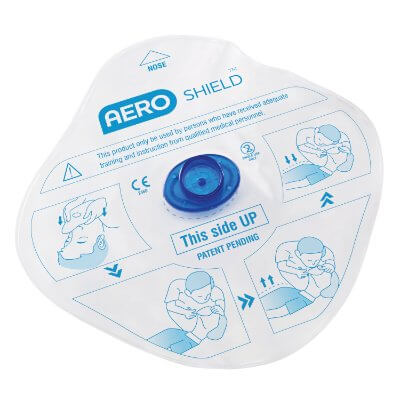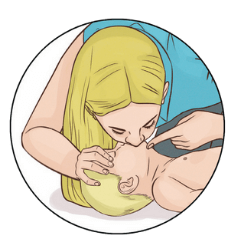4.4 B – Rescue Breathing (Infants & Children)
When to Provide Rescue Breathing
Rescue breathing should be performed when an infant or child has a pulse but is not breathing normally (e.g., gasping or apneic).
Rescue Breathing Methods
- A
Barrier Device (Child/Infant)
(e.g., pediatric face mask or pocket shield)×Barrier Device (Child/Infant)
 © FAW Training Solutions – All rights reserved
© FAW Training Solutions – All rights reserved - A
Bag-Mask Device (Pediatric)
, preferred for healthcare providers×Bag-Mask Device (Pediatric)
 © FAW Training Solutions – All rights reserved
© FAW Training Solutions – All rights reserved -
Mouth-to-mouth-and-nose
for infants if no equipment is available×Mouth-to-mouth-and-nose
 © FAW Training Solutions – All rights reserved
© FAW Training Solutions – All rights reserved
Bag-Mask Ventilation (For HCPs)
Two-Rescuer Technique
- Rescuer 1: Opens the airway and ensures a tight mask seal
- Rescuer 2: Squeezes the bag to deliver ventilations
Proper Technique
- Position yourself at the top of the victim’s head.
- Place the mask over the mouth and nose, aligning it with the bridge of the nose.
- Use the
E-C Clamp Technique
to create a proper seal:×E-C Clamp Technique
 © FAW Training Solutions – All rights reserved
© FAW Training Solutions – All rights reserved- Thumb and index finger form a C shape on the mask.
- The remaining fingers lift the jaw upward, forming an E shape.
- Deliver each breath over 1 second while observing for visible chest rise.
- Avoid excessive ventilation to prevent gastric inflation.
Rescue Breathing Guidelines
- Give 1 breath every 3–5 seconds (approximately 12–20 breaths per minute).
- Reassess pulse every 2 minutes.
- Begin full CPR if the pulse is lost or breathing remains absent and ineffective.
Ventilation Reference Table
| Condition | Rescue Breathing (Pulse Present, No Normal Breathing) |
CPR Ventilations (With Compressions) |
|---|---|---|
| Infants & Children | 1 breath every 3–5 seconds (12–20 breaths per minute) |
15:2 ratio (if two rescuers) |
| Adults | 1 breath every 5–6 seconds (10–12 breaths per minute) |
30:2 ratio |